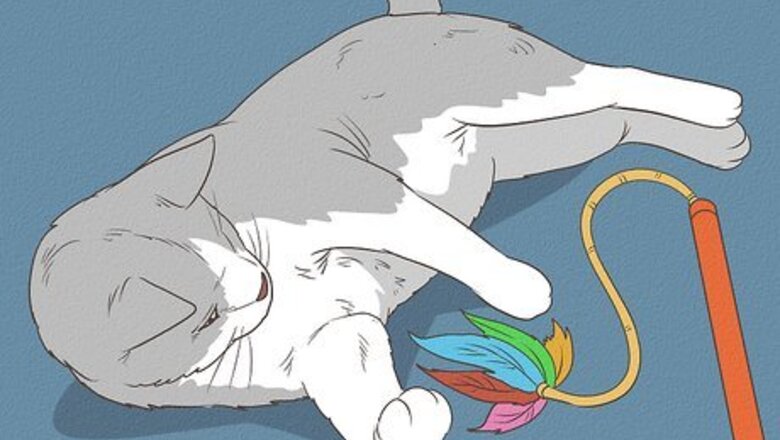
views
Using a String and a Toy

Activate your cat's natural hunting instinct. Get your cat to stalk a rope, a wind-up toy, or a fluffy or feathered toy tied to a string. A piece of string with something fluffy attached to it is one of the simplest toys that you can make, and it is also one of the most effective. Use an old stuffed animal that you don't mind letting a cat chew on. Try to find objects that are smaller than your cat, roughly the size of its natural prey (small birds and rodents). If you don't have a stuffed animal, you can just drag a string around — there's a good chance that your cat will still try to "hunt" the end of the string. It helps when a toy makes some kind of sound to grab your cat's attention, whether it squeaks, rattles, or clicks. Cats have very good hearing, so even a piece of rope sliding over the floor may be enough sound to grab their attention. For cats, playing also functions as training for hunting skills. Play and hunting often go hand-in-hand, and cats will use their claws to bat at anything that holds their attention. It is very easy for a cat to use its imagination, but you need to activate it sometimes. A piece of rope lying limply by itself isn't a prey-like toy. However, when you grab that rope and pull it away from your cat, it will trigger your cat into hunting for its prey. These toys mimic the motion of birds flying in the air, which cats love to chase after.

Tie a string to the toy. Tie a noose into a length of twine and loop the noose around the toy's neck. You can also tie the string to the toy's tail, midriff, or leg — anything that allows you to jiggle the toy in a lifelike manner. Make sure that once you've tied the toy, it can stand up on its own. A floppy old stuffed animal won't fool your cat for long. It needs to be able to stand!
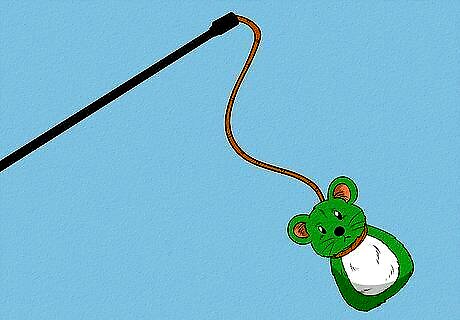
Tie the twine onto a stick. You can simply hold the string in your hand to make the toy move, but an extra degree of separation between your hand and the stuffed animal may help your cat forget that you are the one dangling the toy. Tie the free end of the twine onto a sturdy but comfortable stick.

Tease your cat. Get your cat's attention by dangling the stuffed animal on its string so that the cat cannot ignore it, and then make your stuffed animal stand still, upright, facing your cat. Wait for your cat to pounce on the stuffed animal, then pull it away. Try to entertain him by both letting him grab the string, and by letting him almost grab the string. Make the game difficult, but make it possible to "win". The important thing is that you catch your cat's attention with a sudden motion, then keep the toy still enough to give your cat the chance to "stalk" its prey. When cats put their nails into something, they don't want to let go. This is where the fun begins. Once they grab their 'prey' it is your job to make the 'prey' to try to escape from his claws by both alternating between gentle and rude pulling on the rope. Make your cat run around! Guide him with the toy. Make the cat use your furniture as an obstacle, and jump in the air as high as possible. Make your cat run in circles. If you practice this kind of play with your cat often enough, the cat might hold onto the piece of string so fiercely that you can drag him around.
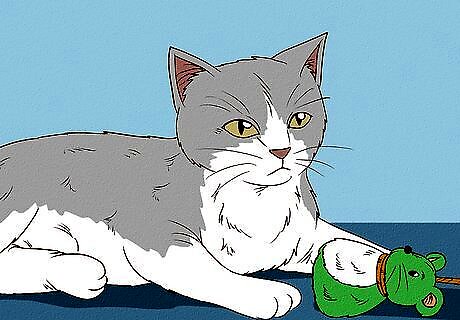
Let cats play when they want to. Give your cat the chance to suss out the situation, and do not interrupt. When the is ready to pounce, it will happen. When the cat is done playing, it will stop. Try not to look at your cat while "fighting" with a toy, and do not hit or push to play with a certain toy.
Using Other Methods
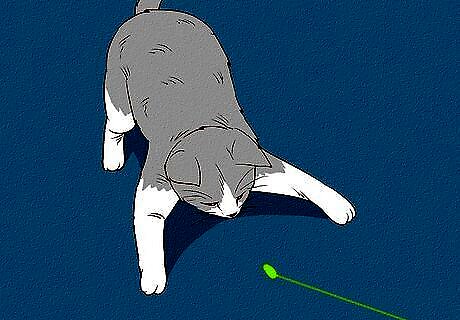
Use a laser pointer to tease your cat. Point the laser at the ground or the wall near your cat. Move the laser to catch your cat's eye, then keep it still for a moment to build suspense. Move the laser around, slowly, and your cat may begin to stalk it like prey. Do not move the laser around too rapidly, or your cat may lose spirit. Just when your cat pounces onto the laser, move it quickly away. You can find laser pointers online, at pet-supply stores and at most technology stores. Be careful not to point the laser into your cat's eyes. Once you have your cat under the spell of the laser, try not to lead it anywhere dangerous. Cats may run headlong into a chair or wall because they are so focused on the dot. Give your cat treats after he's played with the laser pointer. This way, your cat will feel like he's "caught" his dinner.
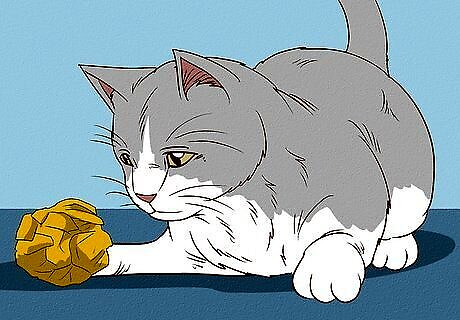
Throw paper or wrappers. Use materials that will make enough noise to catch your cat's attention, but not so much noise to scare your cat away. Ball up the paper, wave it slowly until your cat is tracking it with his eyes, and then throw it a short distance for your cat to chase. This may also work with food or toys.

Use your hand to play-fight. Gently "wrestle" with your cat as though your hand were another cat. Let the cat rub its head against your hand, and let it bat your hand with its hand. Be wary: a cat won't usually use its claws while play-fighting, but it might nibble or bite your hand. Avoid using both hands when playing, as the cat will feel outnumbered and flee. This is, incidentally, a good way of ridding yourself of a playful cat when you're no longer in the mood.
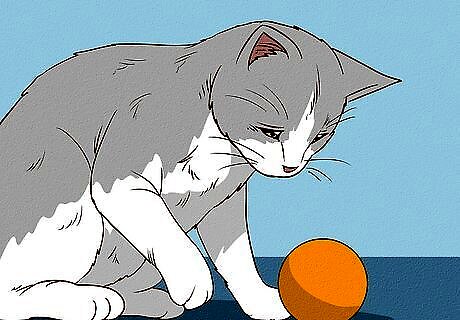
Use a plain ping-pong ball. This might sound boring to you, but many cats love to swat and play with them. Roll the ball gently toward or past your cat to get some attention. If the cat's eyes track the motion of the ball, it means that he sees the ball as potential "prey." Some older cats may not bother to move if you throw the ball.
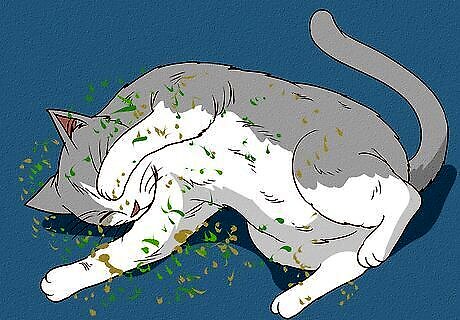
Use catnip. You can give your cat a sprig of fresh or dried catnip, or you can buy a catnip toy for your cat to play with. Many cats love the smell of catnip, and some cats become visibly intoxicated by it. They may stare into space, stumble around, and roll on the floor in pleasure. Be warned that every cat reacts differently to catnip. Your cat may love it, your cat may indifferent, and your cat may even abuse the stuff. Give your cat small amounts of catnip, and watch it for cues. You may also consider buying catnip spray from a pet store and spraying it onto the toys that your cat already has. Spray the catnip spray onto the toys and wait for it to dry. Once it has fully dried, slowly bring out the toys.

Use a plastic egg filled with rice. You can fill a surprise egg or plastic Easter egg with rice and use it to play with your cat. You can even make a little hole on one end of the egg, and pull a thread through it, and make a knot in the thread. The sound of the rice shaking may draw your cat's attention, and the string will help you make the egg seem as though it is moving of its own volition.
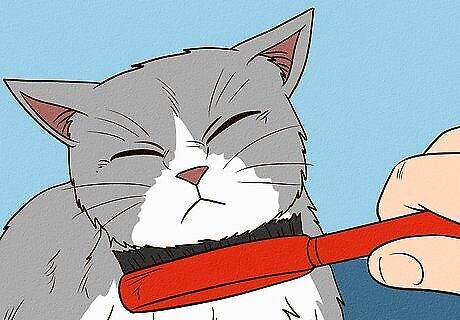
Brush your cat with an animal brush. You can brush their chins, their tails and backs, as well as their bellies. Brush under the tail and on either side, but don't brush your cat's butt. Test it out on your cat, but be aware that not all cats like being brushed. Cats may be wary about you touching their bellies. Don't brush too hard, or else the bristles might hurt your cat.
Giving Your Cat a Box or Bag
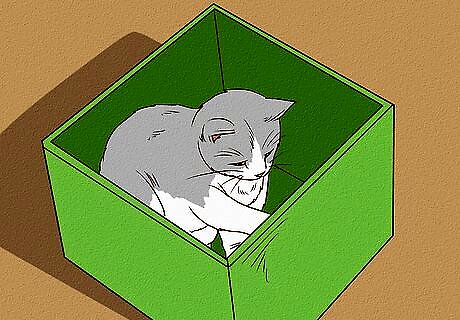
Let your cat play in a box or a bag. If you don't have any spare time to play with your cats, a cardboard box or a shopping bag will provide endless entertainment. Cats might be predators in their natural habitat, but they are not the highest in the food chain, and they love to hide out in small spaces. A box should be large enough for the cat to climb inside, but not so tall that your cat cannot climb out afterward. You can set it upright or on its side, as long as the cat can easily access it. You can use any type of bag that your cat fits inside, but be wary of plastic bags that can trap and suffocate your cat. In general, paper and canvas bags are safer and more breathe-able.
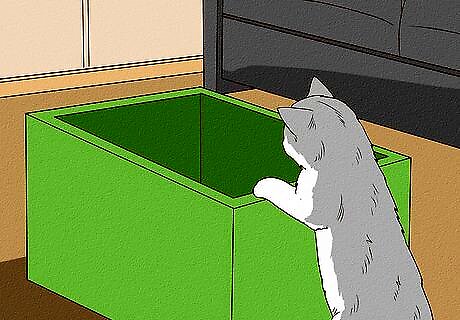
Set the box or bag out where your cat will find it. Make sure to use a space in which your cat is comfortable: a living room, a bedroom, or any place where your cat spends much of its time. Try putting a treat, a toy, or a sprig of catnip into the container to entice your cat inside. Try putting crinkly, noisy paper into the box to give your cat something to explore.
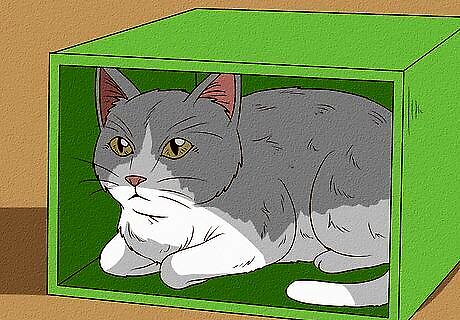
Let your cat use the box or bag on his own terms. You can pick the cat up and put him into the box, but do not force him back in if he climbs out. Avoid tipping the box or bag over while the cat is inside, or else you may give your cat scary associations with the space. Your cat may spend hours at a time resting in the box, and it may become a place that he associates with safety. Never make your cat feel as though he is trapped or cornered. Avoid reaching into the box or looming over the exit, especially if your cat tends to be skittish.
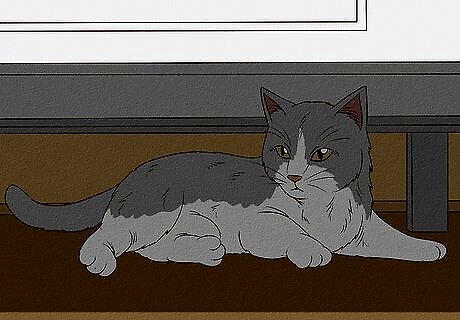
Respect your cat's space. Some cats love to hide out in cupboards and drawers, under beds and blankets, or perched on the tops of furniture and cat trees. Your cat may enjoy a box or bag that you set out, but it may revert to its own "safe spaces".




















Comments
0 comment